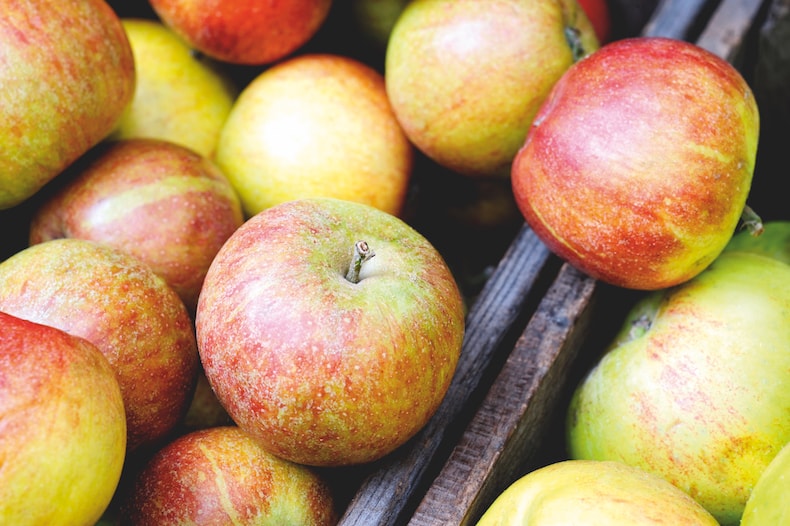From beautiful blossom in spring to comforting crumble in autumn, growing your own apple trees is incredibly satisfying. Here we’ve gathered advice from independent gardening bloggers to help you plant, prune and care for your apple trees and ensure you get bumper crops.
Whether you want to grow dessert apples or cookers, browse our extensive range of apple trees when you’re ready to make a start.
Contents:
- Best general advice on growing apple trees
- Best advice on choosing an apple tree
- Best advice on growing apple trees in small spaces
- Best advice on pruning apple trees
- Best advice on dealing with pests and diseases
- Best advice on harvesting apples
Best general advice on growing apple trees
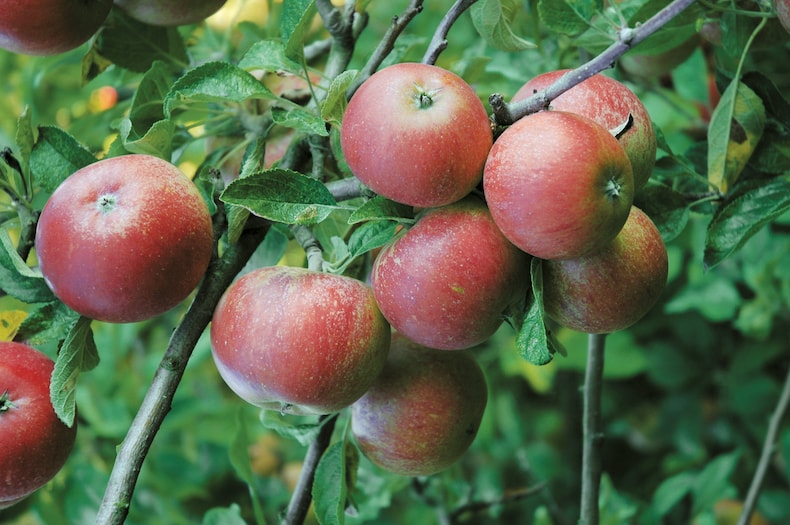
Image: Apple ‘Queen Cox’ (Self Fertile) from Suttons
If you’re considering growing an apple tree from seed, it’s worth noting that apples don’t grow ‘true to type’. For example, if you plant a seed from a Pippin apple, the tree that grows won’t produce Pippin apples, explains Huw Richards in his video on how to germinate apple seeds in the fridge. Visit Huw’s Garden for the full explanation.
If you’re propagating new fruit trees, the best way to guarantee the apples you want is by ‘grafting’, explains Lewis McNeill of The Orchard Project. His helpful video on how to graft an apple tree explains how to take a cutting (‘scion wood’) from your desired variety of tree and fuse it to rootstock. The secret to success? Make diagonal cuts on the joining ends of your scion and rootstock “so that when joined together, as much of the cambium layer (the part of the wood between the outer bark and the woody bit) as possible is touching,” he says.
Buying a bare root apple tree is an easy and economical choice, says Marie Shallcross of Plews Garden Design, although it can take longer to fruit than one grown in a container. Marie admits that she loves the anticipation of planting these “overgrown twigs”. With a larger root mass than container-grown plants, she says that they establish quickly in their new location and “require less water whilst settling in.”
Not sure where and how to plant your new apple tree? A comprehensive article on the Suttons blog recommends a sunny spot with moist but not waterlogged soil. And you should pre-prepare the planting area with compost or well-rotted manure. Once your young tree is in, the horticultural team also suggests supporting it with a strong stake. Read the full article for more practical tips for planting an apple tree.
Best advice on choosing an apple tree
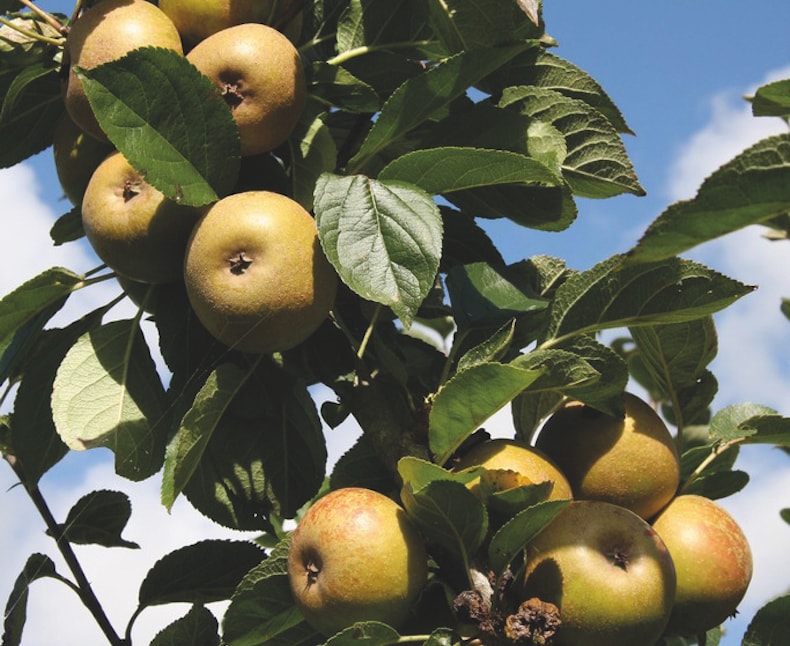
Image: Apple ‘Ashmead’s Kernel’ from Suttons
As YouTuber and orchard owner Stephen Hayes explains, choosing the right varieties of apple trees before you start avoids issues later on. For example, some varieties are biennial (producing apples every other year), while others blossom at very different times, meaning they won’t be able to pollinate each other. In his orchard, apple ‘Sunset’ produces a very reliable and bumper crop. This is great advice whether you have a whole orchard or a small garden.
Permaculture expert Wade Muggleton explains that you don’t always need a pollinating partner on site if you live in an area with lots of established trees, as some insects carry pollen for miles. While being interviewed by Sarah Wilson on her popular Roots And All podcast, he also points out that “the bees get all the publicity but there are all sorts of other insects that do pollination”, including beetles and hoverflies.
Nick from Two Thirsty Gardeners chose ‘Keswick Codlin’ (cooking variety) and ‘Lord Lambourne’ (dessert variety) for his garden. These fall into the same pollination group and produce apples that are rarely found in shops. Check out his apple taste test for an interesting and humorous read.
Marie Shallcross of Plews Garden Design recommends growing apple trees not just for their ability to produce delicious fruit, but also for their decorative blossoms. Different varieties produce different coloured flowers and you may even wish to choose an ornamental apple such as a crabapple over an edible variety.
Best advice on growing apple trees in small spaces
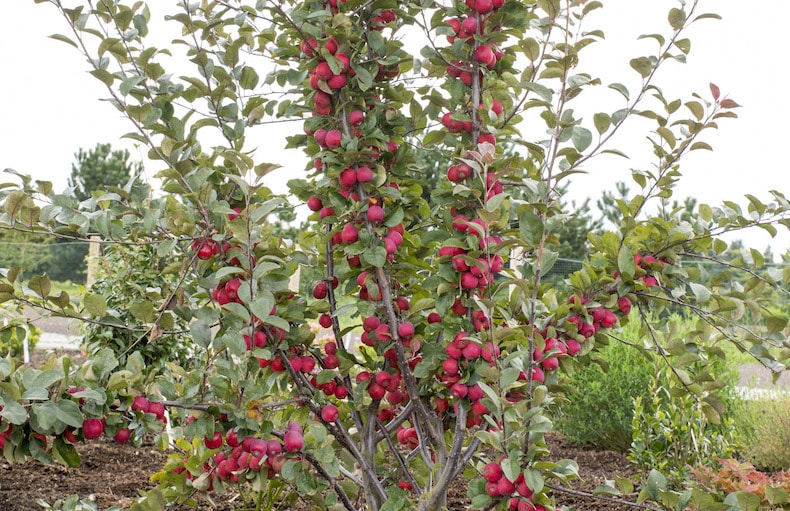
Image: Apple ‘Appeltini’ from Suttons
Even if you don’t have much space, it’s still possible to enjoy an orchard in your garden, says Alexandra Campbell of The Middlesized Garden. Try growing cordon apple trees – single stems that have been trained to grow diagonally or straight up. Each cordon can produce up to 10kg of apples whilst taking up very little space. Alexandra’s advice? Make your apple tree a design feature by planting it as “a screen, or along the fence.”
Over at Simplify Gardening, Tony O’Neill has created a complete guide on how to grow cordon fruit trees. In this informative video he demonstrates how to plant and train a single row of six apple trees on cordon. His final tip – lay some carpet covered with bark chips around the roots to suppress weed growth so that your new trees don’t have to compete for nutrients.
Another highly decorative and space-saving way to train apple trees against a wall or fence is called espalier. Over at The Middlesized Garden, Alexandra Campbell’s brilliant overview of how to grow espaliered fruit trees tells you everything you need to know. When it comes to pruning, Alexandra recommends tying the branches that you want to keep to your framework before cutting away all the others. “Then, if you break a shoot when you’re tying it in, you’ve got another shoot to tie in, rather than an espaliered fruit tree missing one side.”
If you have a sunny patio or balcony, Conor from Hope It Grows suggests growing apple trees in containers. Simply choose a dwarf variety to be sure that it won’t grow too fast or too tall. And if your garden only has enough space for one apple tree, he recommends a self-fertile variety, or a ‘family grafted apple tree’ – a single tree which has several different varieties grafted onto it.
If you choose to grow patio fruit trees, Erica Galpin explains how to transplant a container-grown apple tree in her video over at Erica’s Little Welsh Garden. She recommends repotting into a lightweight plastic container, rather than terracotta, and choosing a pot with straight sides rather than one that tapers towards the bottom, as these are prone to falling over in high winds.
Best advice on pruning apple trees
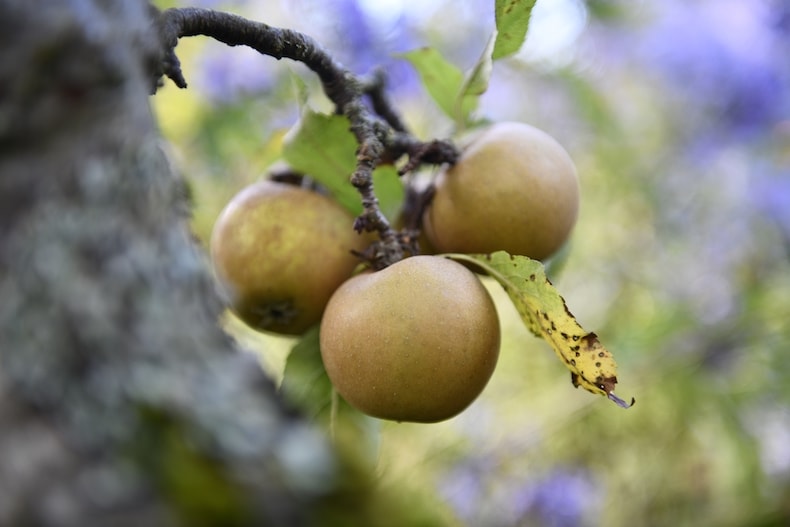
Image: Apple (Malus) ‘Egremont Russet’ from Suttons
Apple trees naturally shed part-formed fruit halfway through the year (known as the ‘June drop’), but if your tree still has crowded trusses of apples well into July, you’ll need to thin them, explains Steven Richards-Price. Filming a how-to video for his son Huw Richards’ YouTube channel, Steven demonstrates which fruits to remove. If you don’t thin the apples on your trees it can lead to ‘biennial bearing’ – a bumper crop one year followed by no apples the next.
Garden Ninja Lee Burkhill’s ultimate beginner’s guide to pruning apple trees is hugely encouraging for those who worry about getting it wrong. In his practical video, he demonstrates the best techniques to encourage healthy growth and good fruit production. Lee explains that pruning in winter, when the tree is dormant, “signal[s] to the tree to divert its energy elsewhere” and stimulates the growth of buds and laterals (side branches).
Summer pruning is done for different reasons but is just as important, as Tony O’Neill of Simplify Gardening explains: “Summer pruning gives you fruiting spurs for next year. Winter pruning gives you growth for next year.” His informative video focuses on how to prune apple trees in summer, cutting back top growth to an outward-facing bud that will go on to produce fruit next year.
Best advice on dealing with pests and diseases
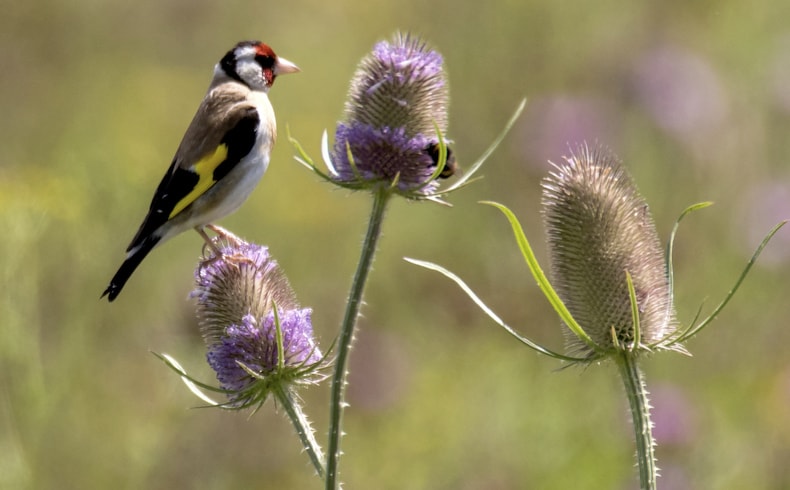
Image: The Birds and Bees Mix Seeds from Suttons
The Orchard Project advocates a holistic approach to caring for apple trees, particularly if you wish to avoid the use of harmful pesticides in controlling pests and eliminating disease. Their advice on guarding against fruit tree pests and diseases (which features a helpful video on how to recognise and treat woolly aphid) highlights the importance of “developing and maintaining a healthy orchard ecosystem, from the soil upwards.”
Over at MandyCanUDigIt, Mandy Watson isn’t keen on the use of fungicides and instead recommends natural remedies. She suggests applying a winter tree wash (a blend of plant and fish oils), but “beware – they absolutely stink, and so will you, if you try and apply it on a windy day!” Her hugely informative article on how to deal with canker, woolly aphid and scab is full of tips to combat these issues without harsh chemicals.
Another natural way to manage pests is to encourage beneficial predators to visit your garden. The Orchard Project’s comprehensive article on beneficial predators for orchards offers advice on how to attract birds, hoverflies, lacewings and other critters that help keep down damaging pests. Top tip? Encourage ladybirds, “the most well-known of the aphid-munchers”, to become frequent visitors to your fruit trees by growing fennel, chives, dill or nettles nearby.
Ann Marie Hendry of GrowVeg has some simple and effective solutions to foil fruit tree pests. To stop rabbits and rodents from stripping the bark (which can be fatal), she recommends making a tree guard out of wire mesh. This is much better than a plastic one, which could be gnawed through and, in Ann Marie’s experience, can encourage disease and harbour pests.
Best advice on harvesting apples
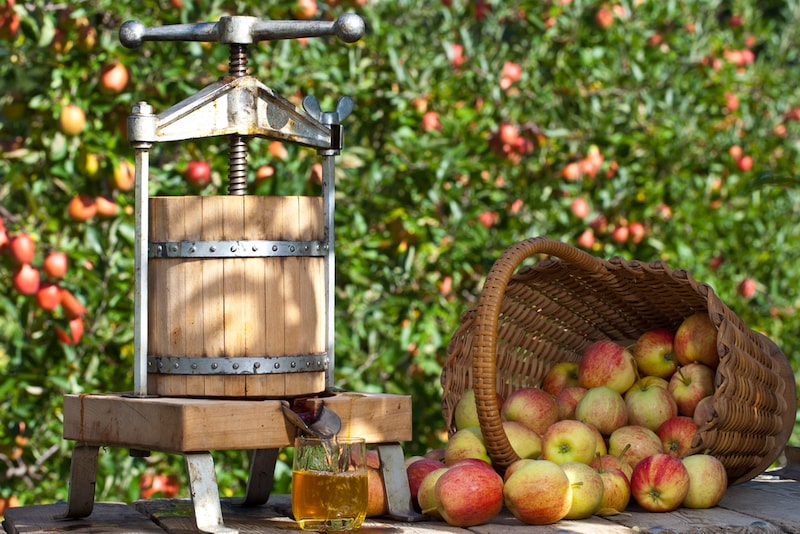
Image: Shutterstock
The best time to pick your apples varies depending on the variety and local climate. To find out if your apples are ready, The Orchard Project’s useful article on when to pick apples and pears recommends giving the fruit a slight twist to see if it will easily come away from the tree. “If you need to give the fruit a yank, or it leaves its stalk behind, or even a bunch of leaves, it is not ready!” The colour of the seeds also gives a good indication – brown pips confirm that the apple has finished ripening.
If you have a bumper crop, you might want to give cider-making a go. Some varieties are better suited to this than others, but “a 50/50 mix of cooking and eating apples will give you a perfectly acceptable cider”, according to Rich of Two Thirsty Gardeners. His easy-to-follow guide to brewing cider shows you how to turn your apples into alcohol with very little specialist equipment. Alternatively if you follow just the first few steps you’ll have your own freshly-pressed apple juice.
Of course, you might want to simply eat the apples you’ve grown. Dessert varieties will be perfect right off the tree, but if you’ve grown cookers then why not try one of these delicious apple recipes from British Apples & Pears.
Karlina Valeiko also has some great suggestions for cooking with apples in her Love Food article, along with a roundup of the best British apple varieties and some background to the British apple industry. Highlighting the health benefits of apples, she notes that eating them with their skin provides 46% more fibre than when they’re peeled, plus a host of vitamins.
Growing your own apples is a rewarding experience that can be achieved whether you have an acre of land, a few square metres of garden, or even just a few containers on a patio or balcony. We hope this selection of expert advice will inspire you to grow your own.
Lead image: Apple Tree ‘Braeburn’ (Clone Helena) from Suttons
Last Updated on November 8, 2024 by Suttons Horticultural Team

